Electric field in our house-Israel
Regarding their electric field, are desk lamps of 2009 more safe than those manufactured in 1980? Apparently, yes. However, in reality, it is the other way round and no institution in the world, including in Israel, has ever warned against the dangers and about the precautions needed to be taken.
Fig. 1 shows three desk lamps used daily in households, offices, schools and in industrial plants.
I decided to make a number of measurements regarding electric field strength and body voltage of three lamps that appear in Fig. 1.
Order of measurements:
· The desk lamp is connected to local utility source (N-L connection) but is off– no light.
· The desk lamp is connected to local utility source (L-N connection) but is off – no light.
· The desk lamp is on – light on.
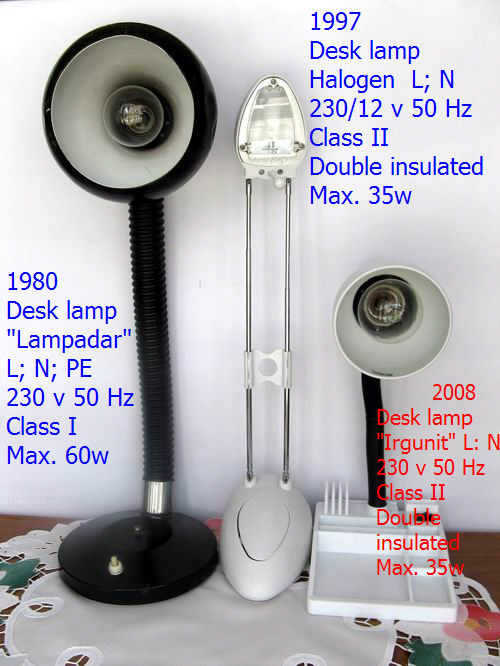
| Fig.1 Desk lamps in our house |
Figs. 2 and 3 show the electric field strength and the body voltage near an Irgunit desk lamp. The appliance in question is “type II” (double insulation), connected to the local utility source via 2 pins plug (N; L).
The plug is type C used in all European countries except for The United Kingdom, Ireland, Cyprus and Malta.

Fig. 2 Irgunit desk lamp-off
Electric field and body voltage measurements |

Fig. 3 Irgunit desk lamp-on
Electric field and body voltage measurements |
Figs. 4 and 5 show the electric field strength and body voltage near a telescopic desk lamp with a halogen bulb. An isolation transformer 230/12 V is installed in the lamp base. This is a "type II" (double insulation) appliance, connected to the local utility source via 2 pins plug (L; N).
The plug is type C used in all European countries, except for The United Kingdom, Ireland, Cyprus and Malta.
Fig. 4 Halogen desk lamp-off
Electric field and body voltage measurements |

Fig. 5 Halogen desk lamp-on
Electric field and body voltage measurements |
Figs. 6 and 7 show the electric field strength and the body voltage near a Lampadar desk lamp manufactured in 1980. It is a “type I” appliance (basic insulation only) and connected to the local utility source via 3 pins plug (L; N; PE).
The plug is type H used exclusively in Israel.
Fig. 6 Lampadar desk lamp-off
Electric field and body voltage measurements |

Fig. 7 Lampadar desk lamp-on
Electric field and body voltage measurements |
The electric field strength and the body voltage measurements that appear in Figs. 2 to 7 are shown in Tables I and II.
| Electrical field |
Lamp off |
Lamp on |
Connection
N-L |
Connection
L-N |
Connection
L+N |
| V/m |
V/m |
V/m |
| Irgunit desk lamp |
17021 |
187 |
7951 |
| Halogen desk lamp |
8055 |
174 |
2982 |
| Lampadar desk lamp |
|
29 |
39 |
| Table I Electric field measurements |
| Body voltage |
Lamp off |
Lamp on |
Connection
N-L |
Connection
L-N |
Connection
L+N |
| V |
V |
V |
| Irgunit desk lamp |
19.08 |
0.922 |
11.15 |
| Halogen desk lamp |
17.19 |
0.877 |
6.75 |
| Lampadar desk lamp |
|
0.019 |
0.015 |
| Table II Body voltage measurements |
The values in tables 1 and 2 raise a few important questions:
· How is it possible that an electric field whose strength is 17000 volt/m emits near our heads or the head of our children when the desk lamps are inactive, i.e., off?
· How is it possible that no international organization has warned the general public about the phenomenon?
· Can adults or children using desk lamps manufactured in 2009 extensively be at a health risk?
· Do other electrical appliances exist in our household that can be responsible for the same hazards?
· Do similar phenomena exist in the USA as well?
· How can it be explained?
· And, most important, what should be done?
In order to answer these questions and receive an updated explanation regarding the phenomenon, I have made several special experiments with new measurements. The experiments are described as follows, and the terms used are: “the cable”, “the bottle”, “the box” and “the surface”.
The Cable
An flexible 3x1 mm2 copper cable is stretched horizontally between two supports and the AC electric field meter is tight to it (Fig. 8). The cable is connected via the local utility source by three separate switches. The results of the experiments show that the maximum value of the electric field strength 17086 volt/m is received when the cable is fed only by the phase voltage-hot in USA- (L). The addition of the neutral connection (N) reduces the electric field to 9257 volt/m (54%) and the grounding connection (PE) also reduces the value to 6937 volt/m (40%).
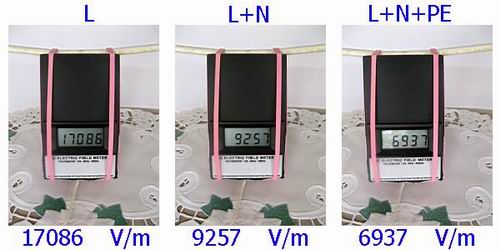
Fig. 8 Cable 3x1 mm²
Electric field measurements |
The Bottle
A flexible 3x1 mm2 copper cable is installed in the axis of a 1.5 liter PVC bottle. The cable is stretched horizontally between 2 supporters (Figs. 9 to 11). The AC electric field meter measures the electric field strength both in the periphery of the bottle and in the air near it. The experiments include 4 states: without sleeve, aluminum sleeve, paper sleeve, cloth sleeve (cotton and polyester).
Fig. 9 PVC bottle without sleeve
Electric field measurements |
Fig. 10 PVC bottle with aluminum sleeve
Electric field measurements |
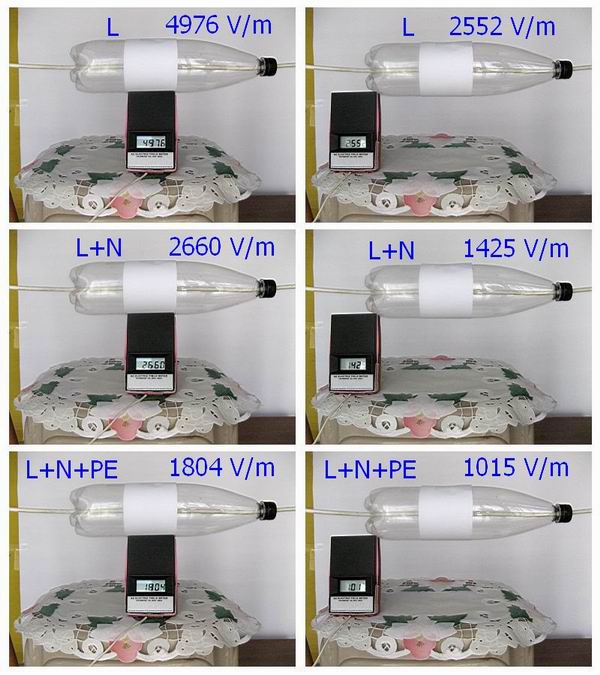
Fig. 11 PVC bottle with paper sleeve
Electric field measurements |
.jpg?id=8863876)
Fig. 12 PVC bottle with cloth sleeve
(cotton+polyester)
Electric field measurements |
| PVC bottle |
Connection
L |
Connection
L+N |
Connection
L+N+PE |
| V/m |
V/m |
V/m |
| Bottle |
Air |
Bottle |
Air |
Bottle |
Air |
| Without sleeve |
2353 |
2370 |
1342 |
1284 |
939 |
937 |
| With aluminum sleeve |
4967 |
2382 |
2674 |
1356 |
1807 |
940 |
| With paper sleeve |
4976 |
2552 |
2660 |
1425 |
1804 |
1015 |
With cloth sleeve
(cotton+polyester) |
3282 |
2441 |
1808 |
1345 |
1198 |
964 |
| Table III PVC bottle-electrical field measurements |
The Box
The experiment is similar to the previous one, except the cable is planted in the axis of a cardboard box with three states: aluminum sleeve, sleeveless (cardboard), in the air near the box.
Fig. 13 Cardboard box with aluminum sleeve
Electric field measurements |

Fig. 14 Cardboard box without sleeve
Electric field measurements |

| Fig. 15 Near the cardboard box (in the air)Electrical field measurements |
| Cardboard box |
Connection
L |
Connection
L+N |
Connection
L+N+PE |
| V/m |
V/m |
V/m |
| With aluminum sleeve |
10623 |
5663 |
3912 |
| without sleeve |
10759 |
5729 |
3953 |
| In air |
3404 |
1786 |
1216 |
| Table IV Cardboard box-electric field measurements |
The Surface
An Irgunit desk lamp is laid on a PVC surface, connected to the local utility source in three states:
· N-L connection – light off
· L-N connection – light off
· N+L connection – light on
The electric field meter is measuring the electric field strength of various objects (note pad, pen holder, wooden table spoon, sheet of paper). The distance between the lamp base and the electric field meter is 17cm. The results are shown in Table 5.
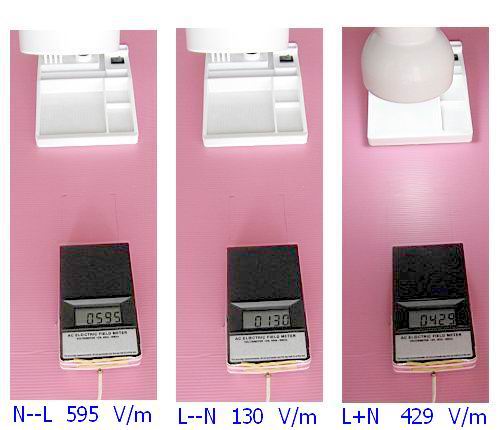
| Fig. 16 PVC surface without objects Electric field measurements |
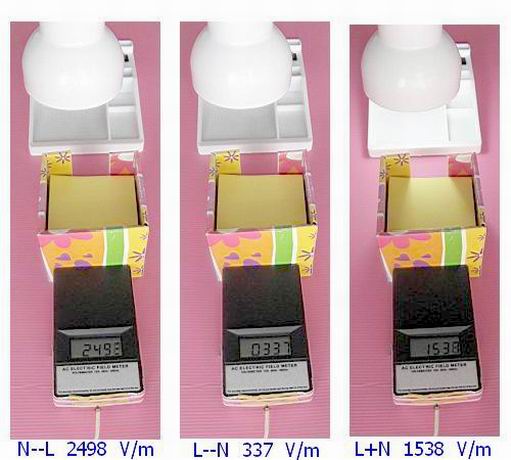
Fig. 17 PVC surface with note pad
Electric field measurements |
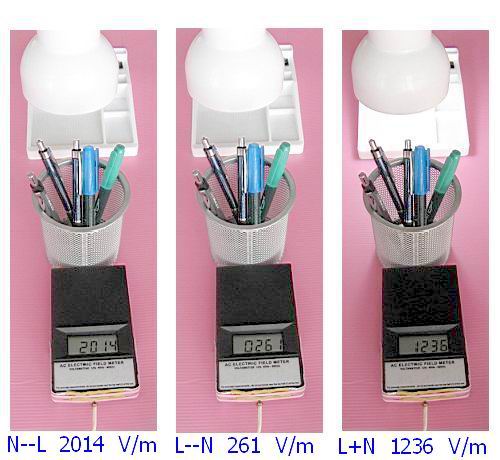
Fig.18 PVC surface with pen holder of metal net
Electric field measurements |
Fig. 19 PVC surface with wooden spoon
Electric field measurements |
Fig. 20 PVC surface with sheet of paper
Electric field measurements |
| PVC surface |
Connection
N-L |
Connection
L-N |
Connection
L+N |
| V/m |
V/m |
V/m |
| Without objects |
595 |
130 |
429 |
| Note pad |
2498 |
337 |
1538 |
| Pen holder |
2014 |
261 |
1236 |
| Wooden spoon |
2122 |
283 |
1315 |
| Sheet of paper |
1373 |
221 |
863 |
| Table V PVC surface-electric field measurements |
Conclusions following the experiments:
· Objects made of paper, metal or china increase the value of the electric field in relation to the electric field in the air, by 2 to 4.
· On a desk full of objects, an electric field of thousands of volt/meter is “running wild”.
· An L-N connection reduces the value by 4 to 8.
The explanation
Why does the electric field strength value depend on the way in which the plug is placed in the socket? And why does the difference increase by tens and even hundreds percent?
For an explanation, which is extremely simple, we ought to return to the data of “The cable” experiment (Fig. 9) and then look at the following Figs. – 21, 22 and 23.
· In the N-L connection and light off -the phase (L) is connected to the input (N) and the neutral to the input (L). Since the switch of the lamp is off, the electric field of the phase is dominant and a high value is received.
· In the L-N connection and light off – the phase (L) is connected to the input (L) and the neutral to the input (N). Since the switch of the lamp is off, the electric field of the neutral is dominant and a low value is received.
· In the N+L connection and light on – the presence of the neutral reduces the electric field value by 50%.
· In a Lampadar lamp, the presence of the grounding reduces the electric field strength to a minimum - less than 40 volt/m near the lamp. There is no difference between on and off.
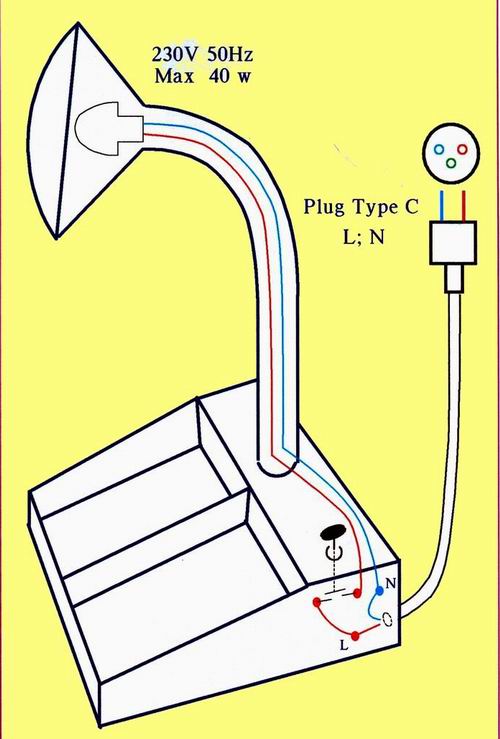
| Fig. 21 Irgunit desk lamp-schematic diagram |
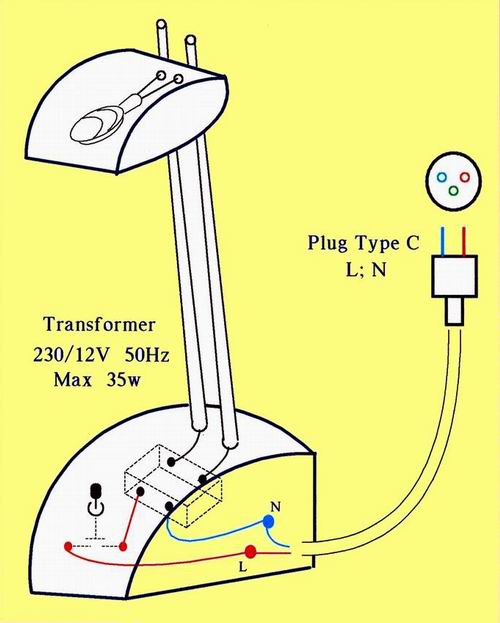
| Fig. 22 Halogen desk lamp-schematic diagram |
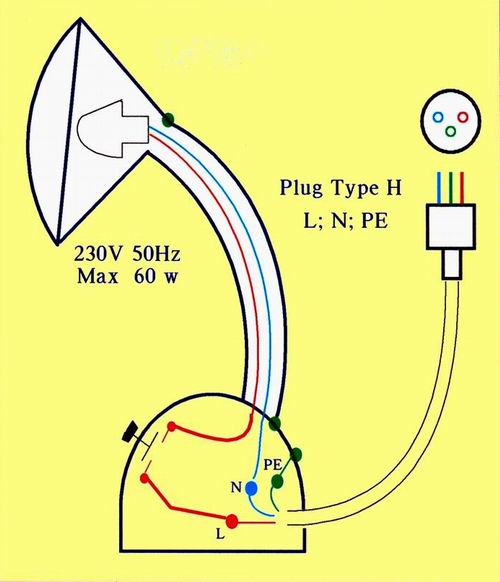
| Fig. 23 Lampadar desk lamp-schematic diagram |
Do other domestic and industrial appliances exist, with the same phenomena?
Yes. All electrical appliances with double insulation and are operated with a single phase switch.
Domestic appliances - such as mixer, hair drier, floor ventilator, table ventilator, vacuum cleaner, food processor, sewing machine, etc.
Industrial appliances – such as drill, hammer drill, grinder, jig saw, circular saw, sander etc.
The electric field strength of the domestic appliances connected via a 3 pins plug-L; N; PE- (such as washing machine, refrigerator, oven, computer) is minimal.
Do similar phenomena occur in the USA as well?
No. In the USA the appliances are connected to the local utility source – 120 volt, 60 hertz – via an A model plug (Fig. 24) enabling only L-N connection. Did people in the USA know about the phenomenon? No. It was used for safety purposes only. (See link)
http://en.wikipedia.org/wiki/Domestic_AC_power_plugs_and_sockets#Polarised_plugs)
| Fig. 24 Plug A+socket -in USA |
The invasion
Yes, invasion. Since 1980, almost all of the electronic appliances introduced in our homes have included switched-mode power supply or SMPS.
Switched-mode power supplies were developed in the military industry and, thanks to their advantages, very quickly conquered the media and the computer industry (Figs. 25, 26 and 27).
Advantages
· Light weight, comparing to the old power supply (linear power supply or thyristors)
· Small size
· High efficiency 70% - 75%
· Durability during hold up time 16ms (Linear power supply or thyristors only 4 ms).
In principal, the switched-mode power supplies are composed of four main units: (Figs. 27 – 28)
· An 1 phase or 3 phase rectifier without isolating transformer, whose role is to rectify AC and supply energy to the converter,
· Static converter whose aim is to convert the output DC voltage of the rectifier to alternating high frequency voltage (20 -:- 100 KHz), to stabilize the output voltage of the supplier as well as to ensure the limitation of the current in case of short circuit in the output.
· High frequency transformer for galvanized separation between input to output, as well as to adjusting the voltage to the input of the output rectifier.
· Output rectifier whose aim is to rectify high frequency alternating voltage to suitable direct current voltage.
In comparison to the linear power supplies or thyristors, prominent among switched-mode power supplies absence of input transformer, and this fact explains the advantages of small size and light weight. It is the same for the output transformer and for the filter circuit in the output, which work in high frequencies and contribute to the improvement of its efficiency.
But switched-mode power supplies are the sources of the electric field, especially when connected to the local utility source without grounding via a 2-pin plug (N: L)
The measurements shown in Figs. 28 and 29 prove the positive effect of the grounding to reduce the electric field strength.
| Fig. 25 SMPS without grounding-schematic diagram |
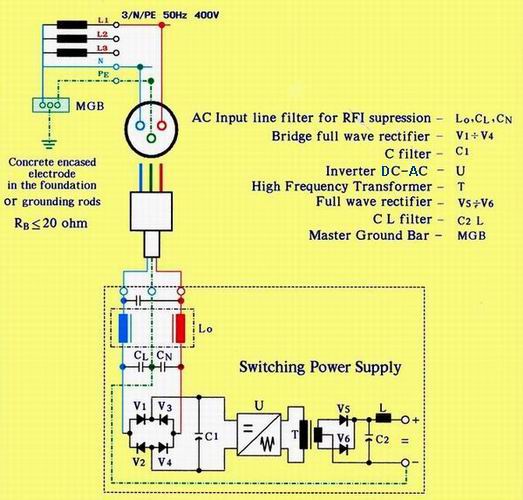
| Fig. 26 SMPS with grounding-schematic diagram |
| Fig. 27 SMPS without covers |
| Fig. 28 SMPS without grounding-electric field measurements |
| Fig. 29 SMPS with grounding-electric field measurements |
Electric field and protection against electric shocks.
In reference to the protection measures against electric shock in Israel (Fig. 30), most of the domestic and the industrial appliances are classified as follows:
TT system –ground conductor of building connected to the metal underground water pipe, up to 1978
TT system – ground conductor of building connected to the concrete encased electrode in the foundation, up to 1984
TN system – ground conductor of building connected to the PEN conductor of the local utility source, since 1984.
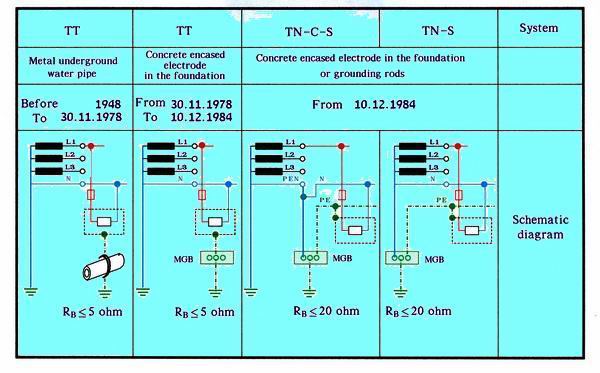
| Fig. 30 Protection against electrical shocks-Israel |
Fig. 30 shows that the use of TN system enables a safe circuit for the discharge of electric field to the grounding. The TT system with connection to the concrete encased electrode in the foundation also enables a safe discharge of electric field. In contrast, the TT system with connection to the metal underground water pipe, introduces one of the more severe problems both for protecting from electric shock and for the discharge of electric field. It has been known that the grounding method with connection to the metal underground water pipe is an inheritance from the British Mandate period, a standard method in England too. But in 1940, eight years before the English left The Land of Israel, the English had decided to adopt the P.M.E system. We have been left with the old one, for better and for worse. Only in 1984, with the publication of the electricity regulations (groundings and protection against electric shock up to 1000 volt), we have joined the European VDE, IEC regulations, and those alike.
The problems with the grounding conductor connected to the to the metal underground water pipe commenced years ago, right after the 1962 publication of the electricity regulations (grounding, and other protections). The piping system for water supply which was defined as “natural electrode” had turned into a mirage, after the water supply authorities preferred plastic pipes, both for maintenance and for new projects. It became more complicated due to two reasons:
a. The tenants themselves exchange metal pipes for water supply with plastic ones.
b. The tenants renovate their houses, mainly old houses, and exchange the metal pipes under the floor with plastic pipes, hence remaining without protective grounding whatsoever.
In old apartments where the connection to the water pipes is faulted and lacks local electrode, the level of the electric field near the refrigerator, the washing machine, etc., rises to thousands of volt/m and the level of the electric field in the walls rises due to the lack of grounding.
Body voltage
The spread of the electric field in the house is affected by several factors:
· Conductors and cables bedded in the walls and ceilings
· The amount of sockets, light switches and the junction boxes
· The number of electrical appliances with double insulation with a single phase switch, permanently connected to sockets or multi-sockets
· The number of electrical appliances without switch – SMPS
· Ceiling lamps which are not connected to grounding
· A joint wall with a neighboring house
Voltage will appear on all objects – tables, book shelves, sofas, beds, etc., according to the value of the electric field in the vicinity. As a mobile antenna, our body also absorbs voltage called "body voltage".
If an Irgunit table lamp(in state off) is placed on a desk and connected N-L to the local utility source, the body voltage near the desk reaches 1500 mv. When our hands are placed on the table for writing, the body voltage rises to 2500 to 4000 mv.
If a “Lampadar” table lamp is placed on a desk, on or off, the body voltage near the desk or while writing is between 150 to 200 mv.
In bed, the body voltage is affected by the amount of the electrical appliances near by. Radios and double insulation lamps raise the body voltage to 1500 to 2500 mv.
What is the permitted level of body voltage in the house? The World Health Organization (WHO) or the International Agency for Research on Cancer (IARC) do not refer to this data, but there exist world organizations who recommend values according to the precautionary principal, According to the 2008 German Standard of Building Biology (SBN), the permitted level of body voltage in our sleeping areas should be less than 10 mv.
http://www.baubiologie.de/downloads/english/richtwerte_2008_englisch.pdf
In the USA as well, an emphasis is put over decreasing the body voltage in bed. The American public is urged to get a kit for shutting off the power in the bedroom as well as a digital multimeter for measuring body voltage, all via the internet.
http://www.safelivingtechnologies.ca/EMF/products_emf_ds_auto.htm
http://www.safelivingtechnologies.ca/EMF/products_emf_body_voltage.htm
Wolfgang Maes, a German journalist, published an article regarding the influence of the reduction of body voltage in bed as early as in 1990. There, he describes 18 cases of health problems that had vanished or improved due to the reduction of the body voltage in bed.
http://www.maes.de/09%20EMF/maes.de%20EMF%20VERSPANNENDE%20SPANNUNG.PDF
What can be done?
It is simple and inexpensive. In Israel, as in the rest of the world, it is easy to purchase a voltage detector – tester- with range between 50 to 600 volt AC (Fig. 31). The tester might confuse the user when trying to discover the phase (hot in USA) of the multi-sockets but will assist them in clearly determining the L-N connection of all the domestic electrical appliances with double insulation and ensure a low electric field value when the appliances are off.
1. Connect the electrical appliance in state off to the local utility source. Approach with the tester, which then begins to signal from a distance of 5 - 10 cm. this means that the appliance is connected N-L and the value of the electric field is high.
2. Reconnect the electrical appliance with a plug, turning it 180 degrees. The signal on the tester disappears or appears only when the tester touches the appliance itself. The appliance connection is L-N with low electric field.
3. Mark the level on the plug of the appliance, so as to remember how to connect it for reuse.
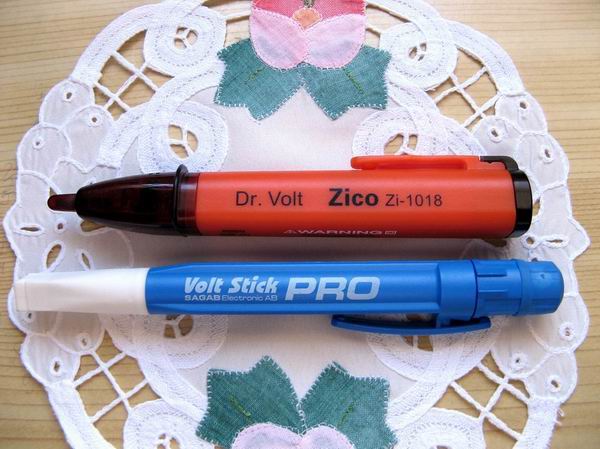
Conclusions
The following conclusions arise from the above explanation:
· Only Lampadar lamps, or alike, (metal body connected to ground) can reduce the electric field strength to a minimum on the desk, both when they are on or off.
· Marking the plug for L-N connection enables the reduction of the electric field strength for all electrical appliances with double insulation that are operated with a single phase switch.
· Objects made of metal, cloth, paper, wood, china, etc. raise the value of the electric field comparing to the electric field in the air.
Recommendations
Is it worthwhile to replace desk lamps double insulation with desk lamps that metal body connected to ground?
· Definitely. Yes. To exchange at home, at school, in hi-tech companies and in all institutions where people use lamps for long hours.
· To my best knowledge, it is hard to maintain the recommended value of mv <10 without stopping the electrical voltage in the bedroom– as is done in the USA and in Germany- but it is possible to get less than 100 mv, if on the bedside chest no electrical appliance is placed and if the bed is far from the socket.
· Remember, unlike 1980, in 2009 the magnetic field strength of table lamp with a 60 w bulb have not changed near the desk, but the electric field values have increased in tens and even hundred percent.